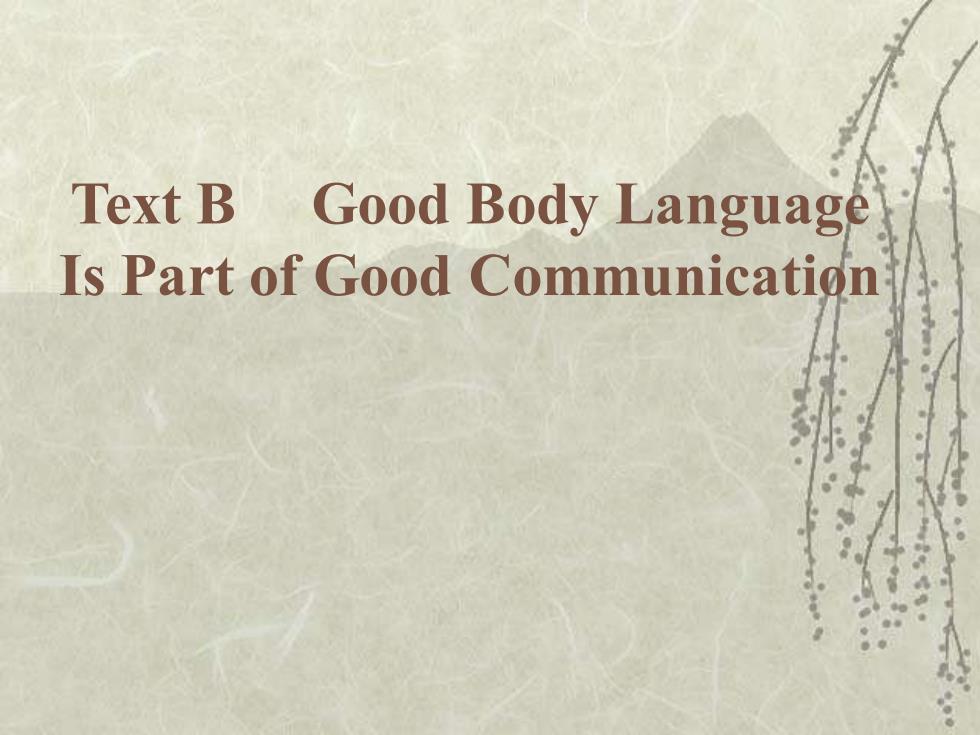
Text B Good Body Language Is Part of Good Communication
Text B Good Body Language Is Part of Good Communication
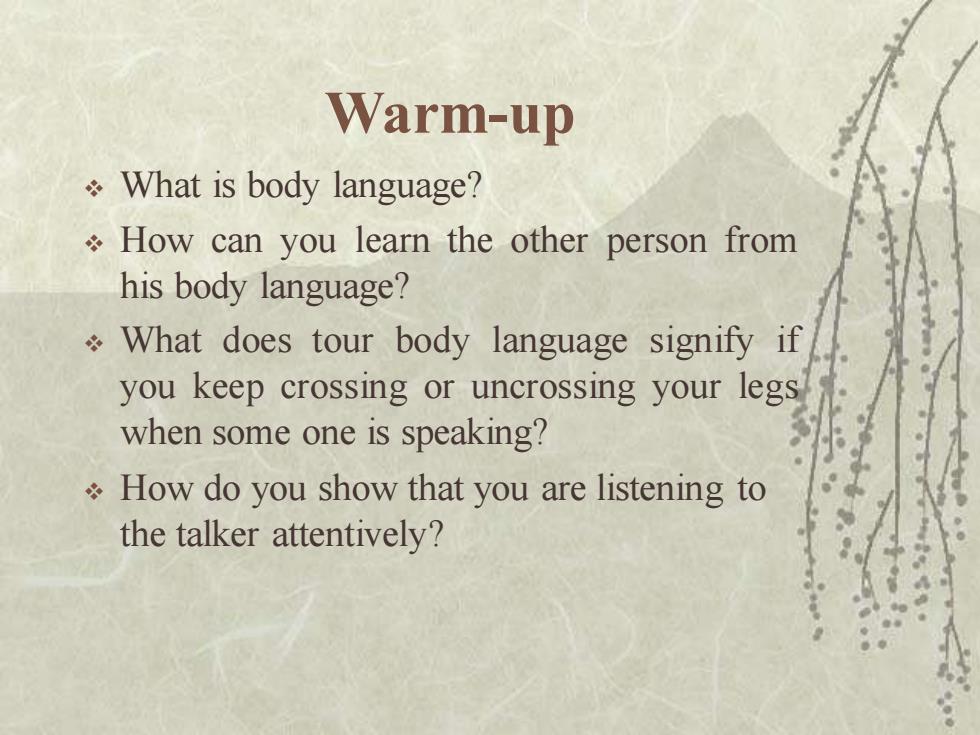
Warm-up What is body language? How can you learn the other person from his body language? What does tour body language signify if you keep crossing or uncrossing your legs when some one is speaking? How do you show that you are listening to the talker attentively?
Warm-up ❖ What is body language? ❖ How can you learn the other person from his body language? ❖ What does tour body language signify if you keep crossing or uncrossing your legs when some one is speaking? ❖ How do you show that you are listening to the talker attentively?
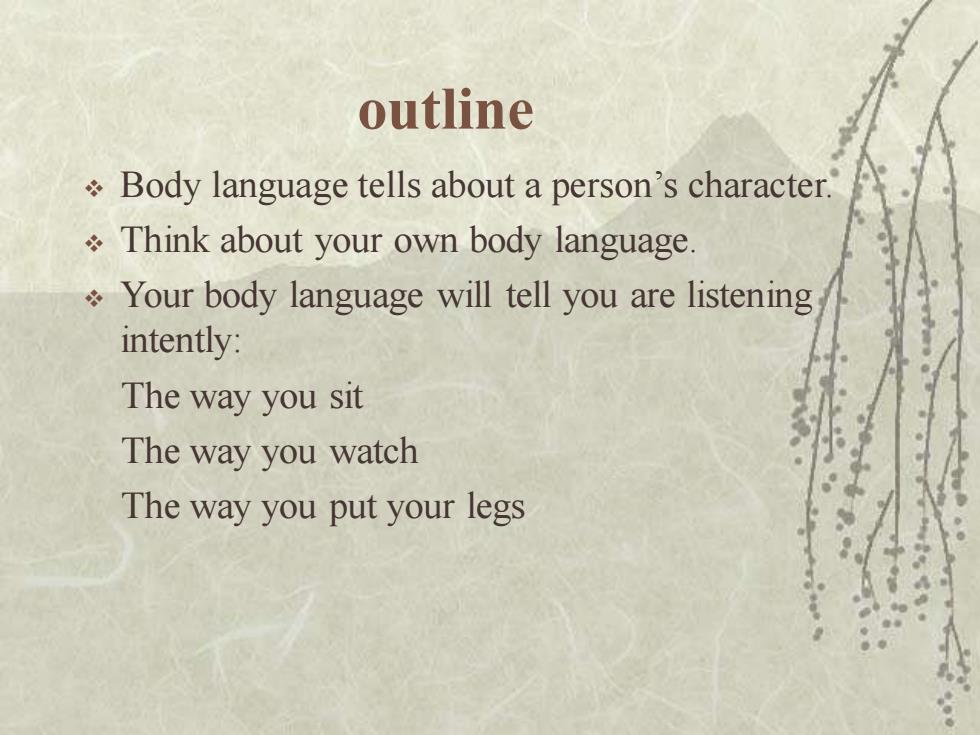
outline Body language tells about a person's character. Think about your own body language. Your body language will tell you are listening intently: The way you sit The way you watch The way you put your legs
outline ❖ Body language tells about a person’s character. ❖ Think about your own body language. ❖ Your body language will tell you are listening intently: The way you sit The way you watch The way you put your legs
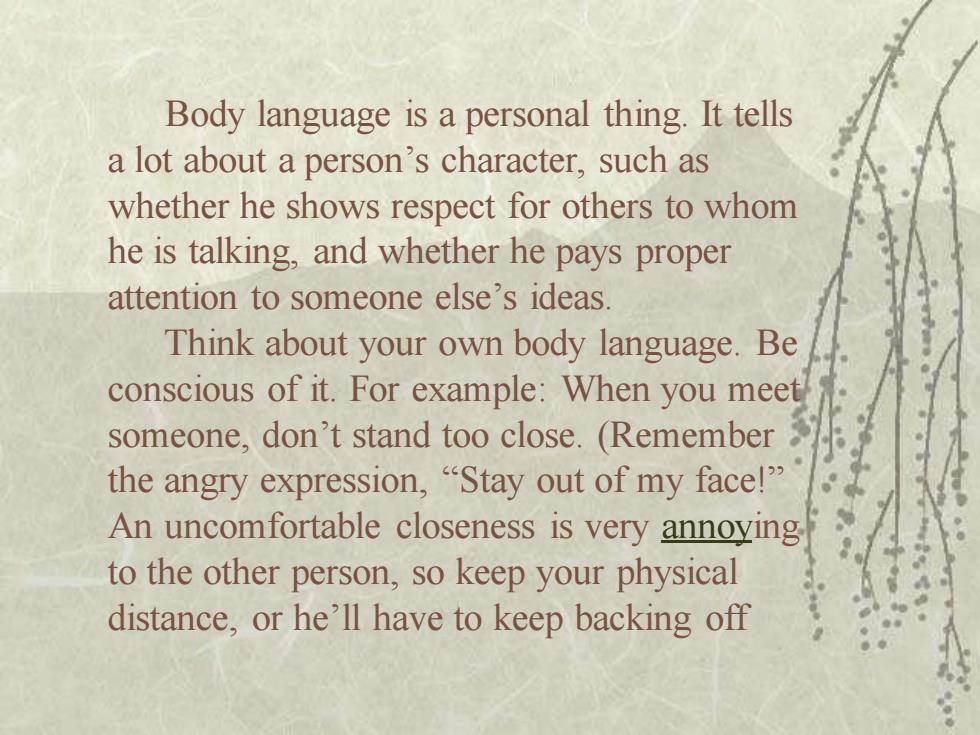
Body language is a personal thing.It tells a lot about a person's character,such as whether he shows respect for others to whom he is talking,and whether he pays proper attention to someone else's ideas. Think about your own body language.Be conscious of it.For example:When you meet someone,don't stand too close.(Remember the angry expression,"Stay out of my face!" An uncomfortable closeness is very annoying to the other person,so keep your physical distance,or he'll have to keep backing off
Body language is a personal thing. It tells a lot about a person’s character, such as whether he shows respect for others to whom he is talking, and whether he pays proper attention to someone else’s ideas. Think about your own body language. Be conscious of it. For example: When you meet someone, don’t stand too close. (Remember the angry expression, “Stay out of my face!” An uncomfortable closeness is very annoying to the other person, so keep your physical distance, or he’ll have to keep backing off
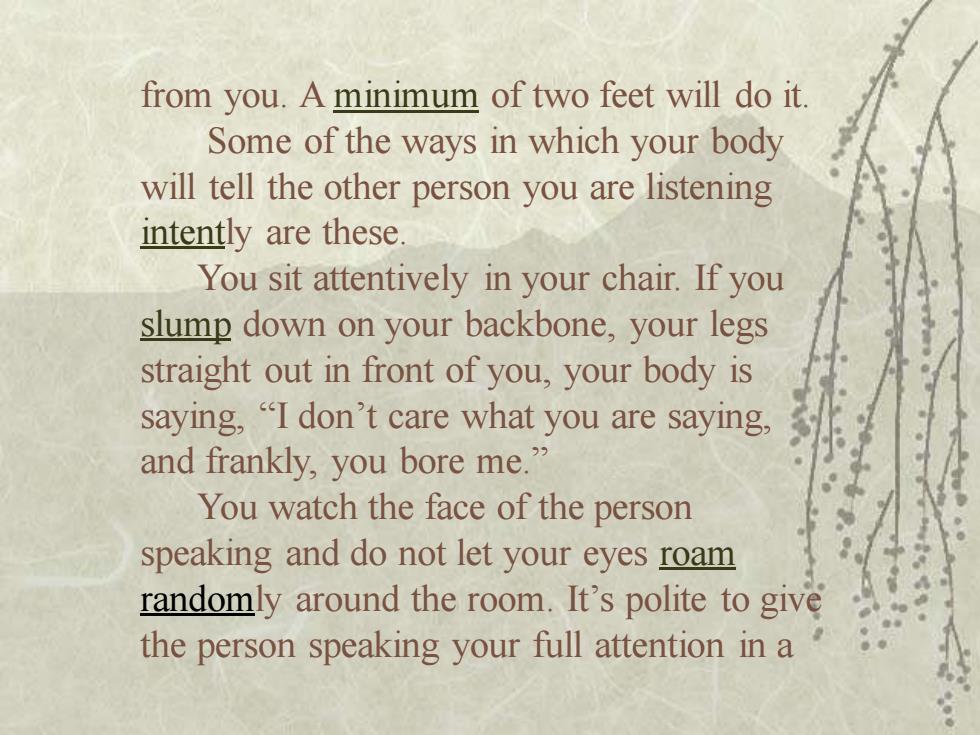
from you.A minimum of two feet will do it. Some of the ways in which your body will tell the other person you are listening intently are these. You sit attentively in your chair.If you slump down on your backbone,your legs straight out in front of you,your body is saying,"I don't care what you are saying, and frankly,you bore me." You watch the face of the person speaking and do not let your eyes roam randomly around the room.It's polite to give the person speaking your full attention in a
from you. A minimum of two feet will do it. Some of the ways in which your body will tell the other person you are listening intently are these. You sit attentively in your chair. If you slump down on your backbone, your legs straight out in front of you, your body is saying, “I don’t care what you are saying, and frankly, you bore me.” You watch the face of the person speaking and do not let your eyes roam randomly around the room. It’s polite to give the person speaking your full attention in a
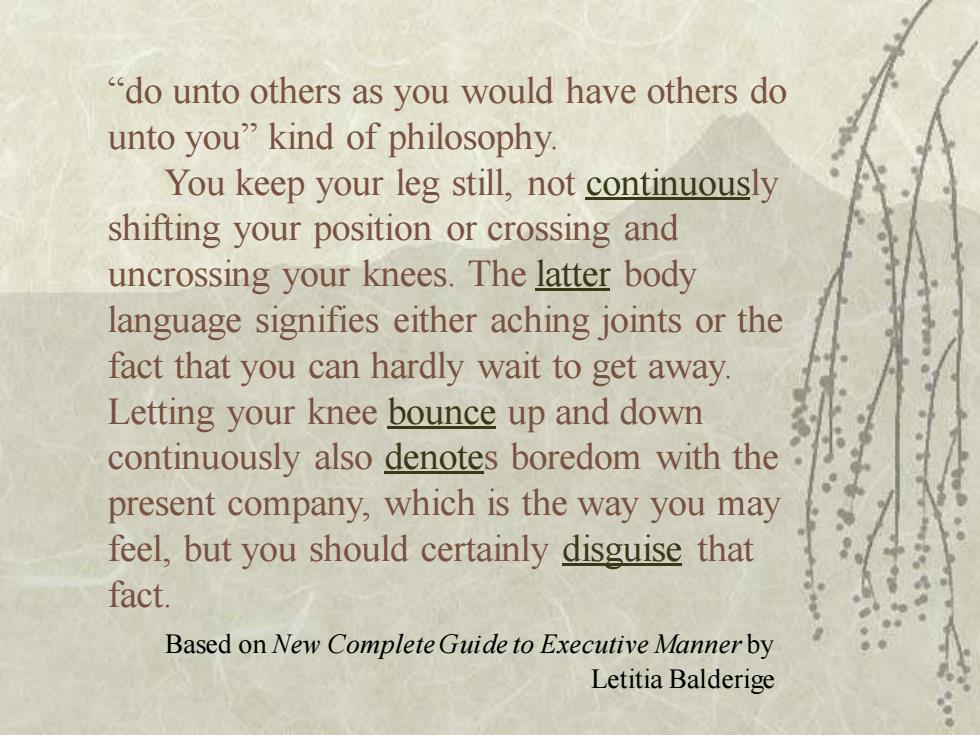
"do unto others as you would have others do unto you"kind of philosophy. You keep your leg still,not continuously shifting your position or crossing and uncrossing your knees.The latter body language signifies either aching joints or the fact that you can hardly wait to get away. Letting your knee bounce up and down continuously also denotes boredom with the present company,which is the way you may feel,but you should certainly disguise that fact. Based on New Complete Guide to Executive Manner by Letitia Balderige
“do unto others as you would have others do unto you” kind of philosophy. You keep your leg still, not continuously shifting your position or crossing and uncrossing your knees. The latter body language signifies either aching joints or the fact that you can hardly wait to get away. Letting your knee bounce up and down continuously also denotes boredom with the present company, which is the way you may feel, but you should certainly disguise that fact. Based on New Complete Guide to Executive Manner by Letitia Balderige
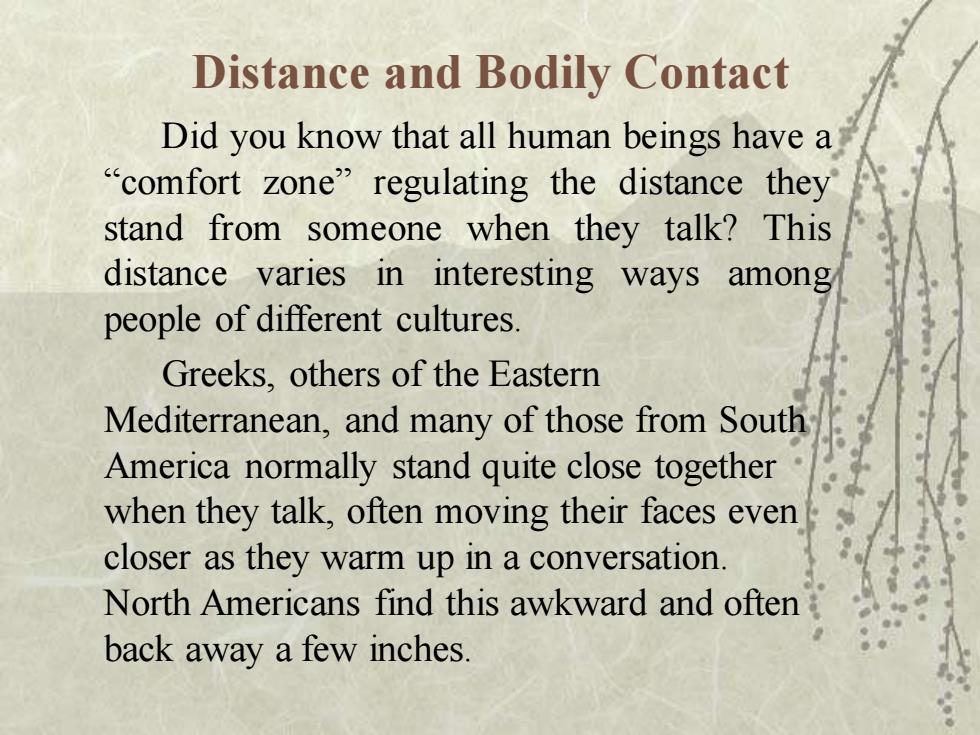
Distance and Bodily Contact Did you know that all human beings have a “comfort zone”regulating the distance they stand from someone when they talk?This distance varies in interesting ways among people of different cultures. Greeks,others of the Eastern Mediterranean,and many of those from South America normally stand quite close together when they talk,often moving their faces even closer as they warm up in a conversation. North Americans find this awkward and often back away a few inches
Distance and Bodily Contact Did you know that all human beings have a “comfort zone” regulating the distance they stand from someone when they talk? This distance varies in interesting ways among people of different cultures. Greeks, others of the Eastern Mediterranean, and many of those from South America normally stand quite close together when they talk, often moving their faces even closer as they warm up in a conversation. North Americans find this awkward and often back away a few inches
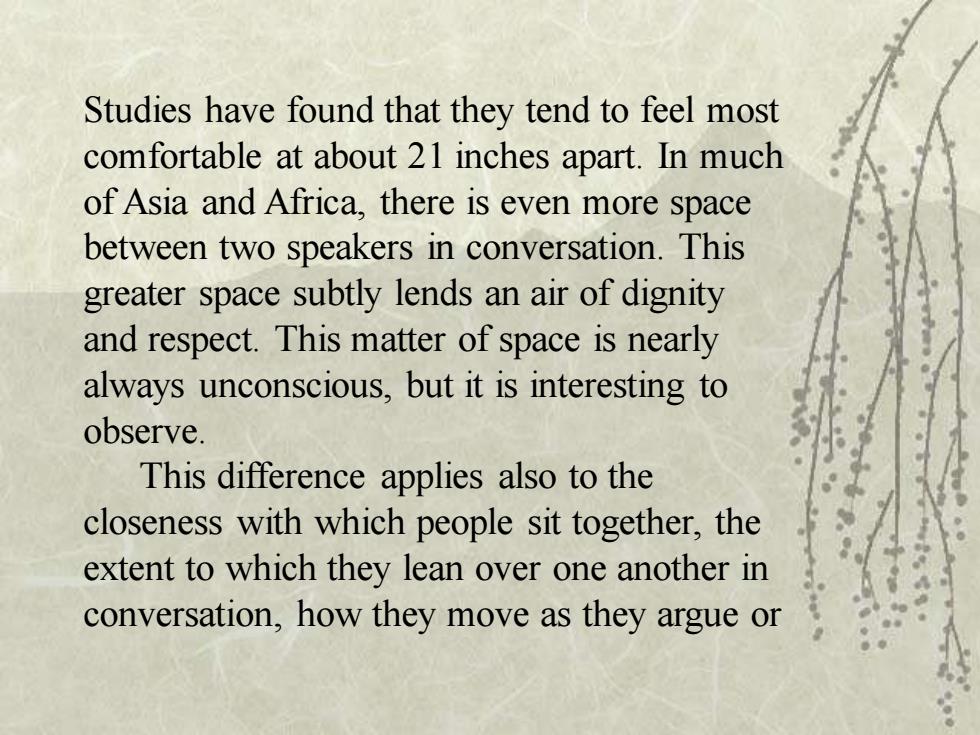
Studies have found that they tend to feel most comfortable at about 21 inches apart.In much of Asia and Africa,there is even more space between two speakers in conversation.This greater space subtly lends an air of dignity and respect.This matter of space is nearly always unconscious,but it is interesting to observe. This difference applies also to the closeness with which people sit together,the extent to which they lean over one another in conversation,how they move as they argue or
Studies have found that they tend to feel most comfortable at about 21 inches apart. In much of Asia and Africa, there is even more space between two speakers in conversation. This greater space subtly lends an air of dignity and respect. This matter of space is nearly always unconscious, but it is interesting to observe. This difference applies also to the closeness with which people sit together, the extent to which they lean over one another in conversation, how they move as they argue or
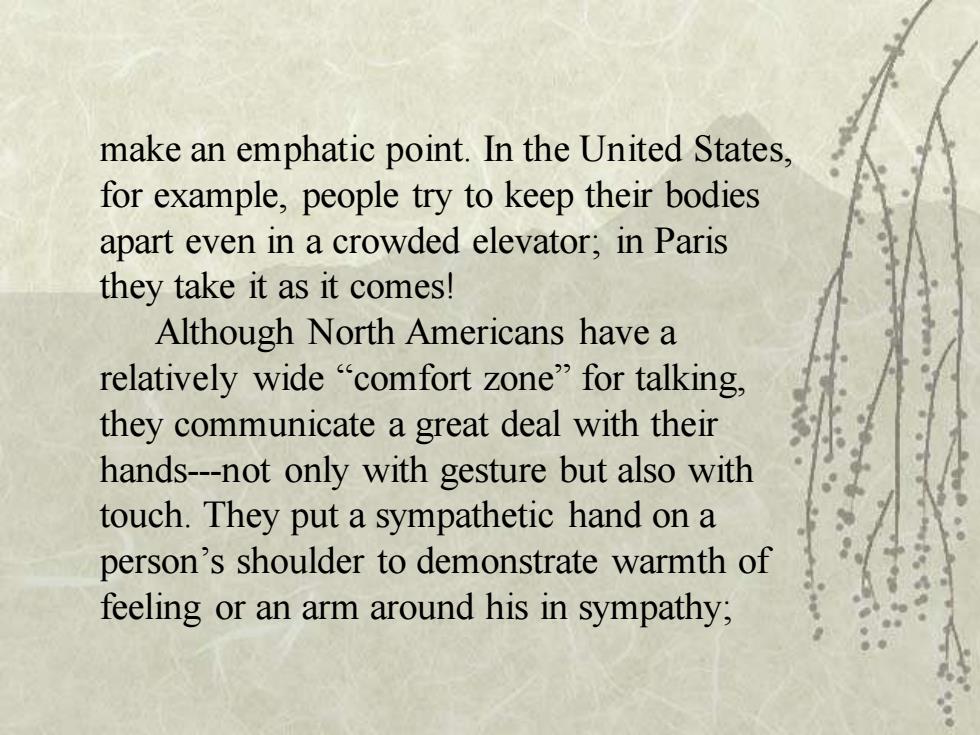
make an emphatic point.In the United States, for example,people try to keep their bodies apart even in a crowded elevator;in Paris they take it as it comes! Although North Americans have a relatively wide“comfort zone”for talking, they communicate a great deal with their hands---not only with gesture but also with touch.They put a sympathetic hand on a person's shoulder to demonstrate warmth of feeling or an arm around his in sympathy;
make an emphatic point. In the United States, for example, people try to keep their bodies apart even in a crowded elevator; in Paris they take it as it comes! Although North Americans have a relatively wide “comfort zone” for talking, they communicate a great deal with their hands---not only with gesture but also with touch. They put a sympathetic hand on a person’s shoulder to demonstrate warmth of feeling or an arm around his in sympathy;

they pat an arm in reassurance or stroke a child's head in affection;they readily take someone's arm to help him across a street or direct him along an unfamiliar route.To many people ---especially those form Asia or the Moslem countries----such bodily contact is unwelcome,especially if inadvertently done with the left hand.The left hand carries no special significance in the U.S.Many Americans are simply left handed and use that hand more. The End
they pat an arm in reassurance or stroke a child’s head in affection; they readily take someone’s arm to help him across a street or direct him along an unfamiliar route. To many people --- especially those form Asia or the Moslem countries ---- such bodily contact is unwelcome, especially if inadvertently done with the left hand. The left hand carries no special significance in the U. S. Many Americans are simply left handed and use that hand more. The End